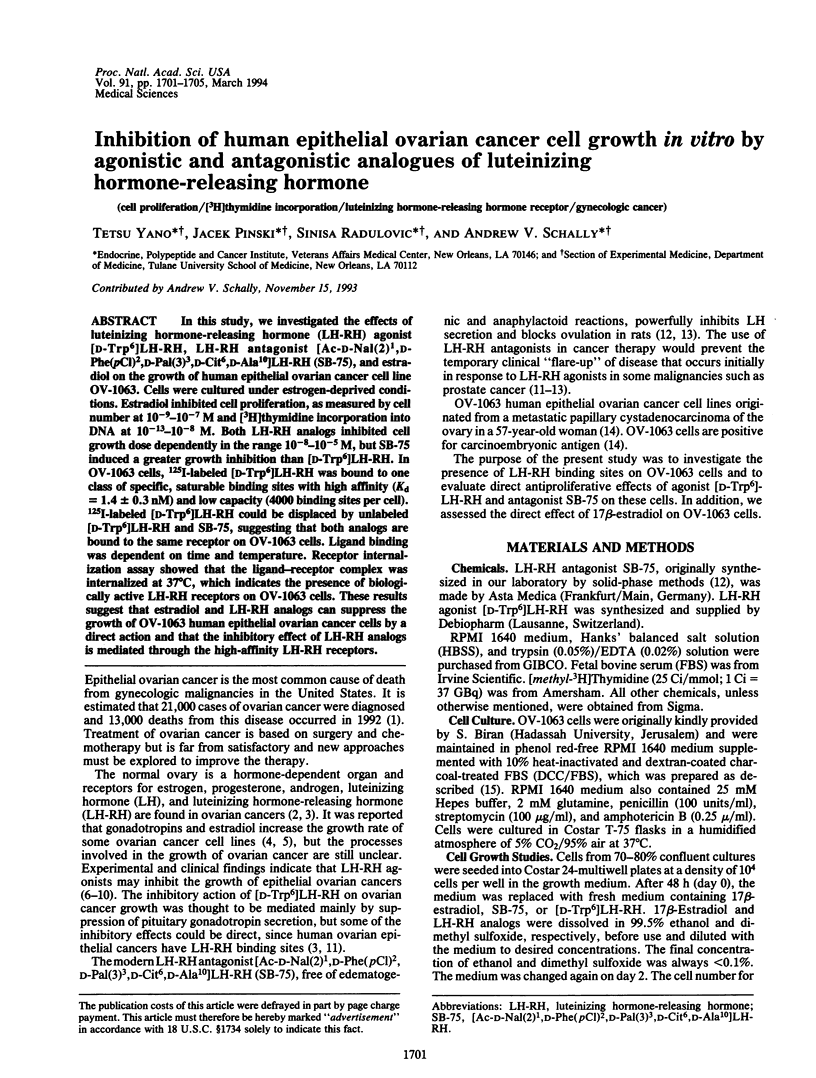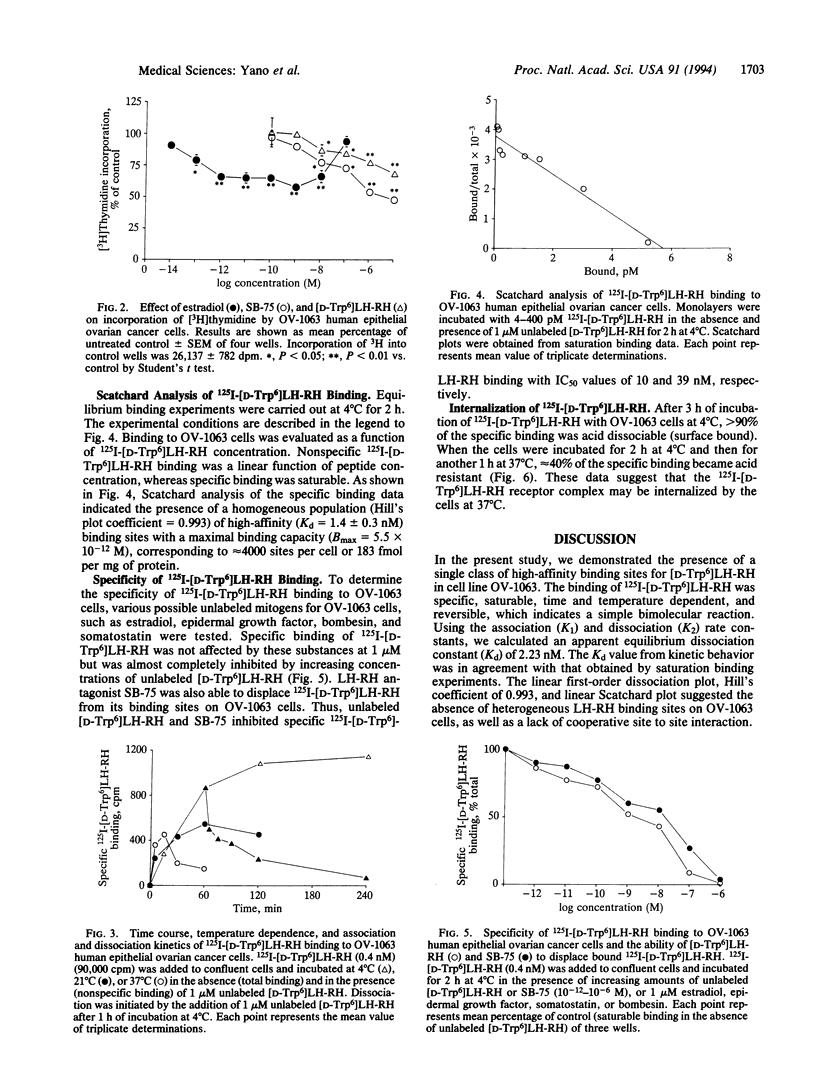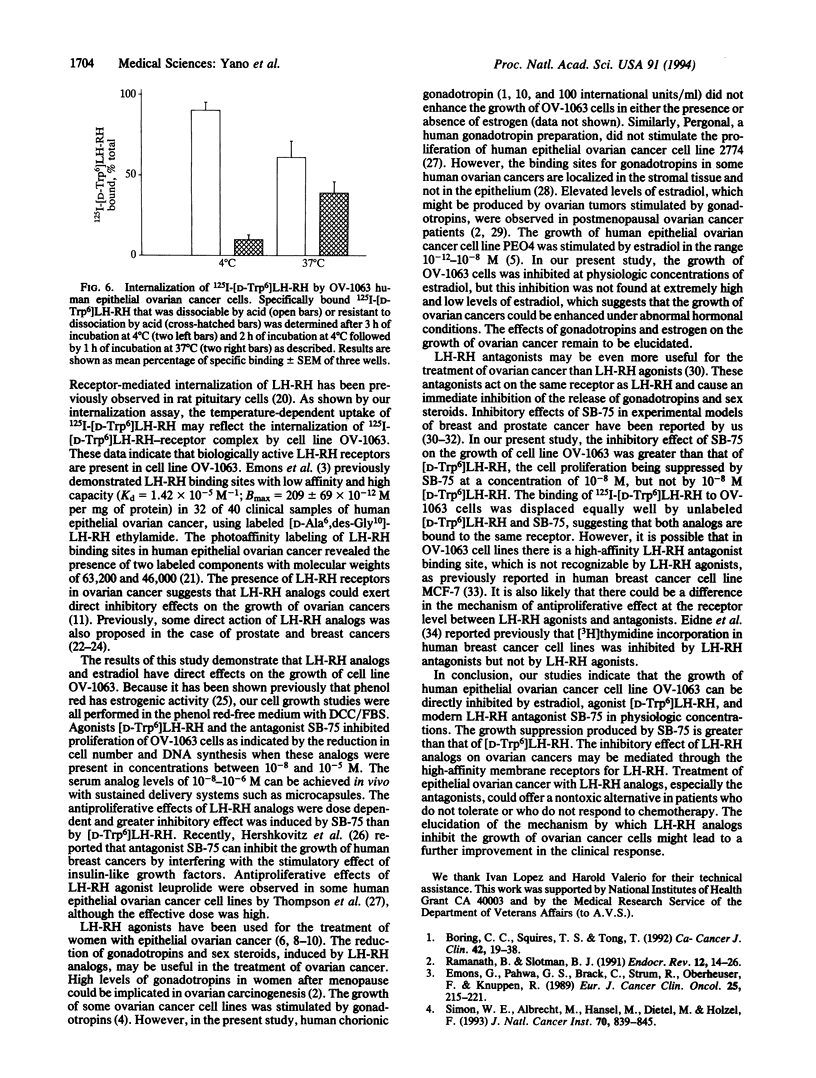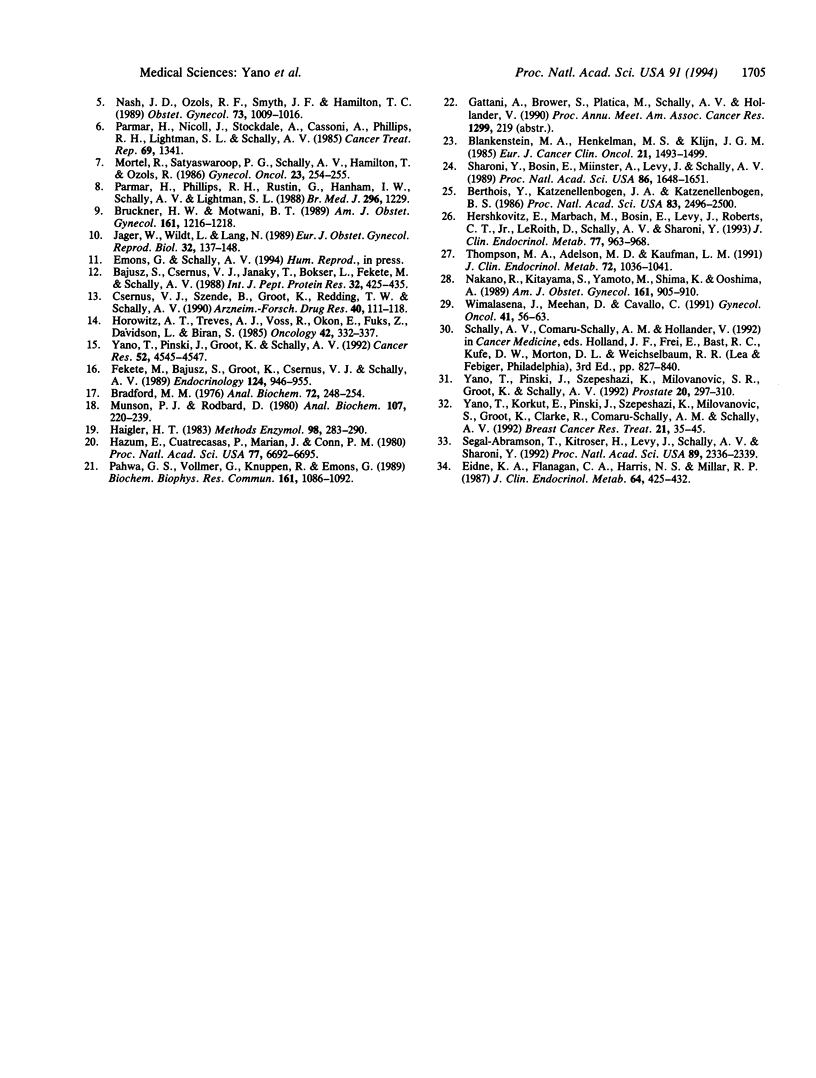Abstract
In this study, we investigated the effects of luteinizing hormone-releasing hormone (LH-RH) agonist [D-Trp6]LH-RH, LH-RH antagonist [Ac-D-Nal(2)1,D-Phe(pCl)2,D-Pal(3)3,D-Cit6,D-Ala10]LH-RH (SB-75), and estradiol on the growth of human epithelial ovarian cancer cell line OV-1063. Cells were cultured under estrogen-deprived conditions. Estradiol inhibited cell proliferation, as measured by cell number at 10(-9)-10(-7) M and [3H]thymidine incorporation into DNA at 10(-13)-10(-8) M. Both LH-RH analogs inhibited cell growth dose dependently in the range 10(-8)-10(-5) M, but SB-75 induced a greater growth inhibition than [D-Trp6]LH-RH. In OV-1063 cells, 125I-labeled [D-Trp6]LH-RH was bound to one class of specific, saturable binding sites with high affinity (Kd = 1.4 +/- 0.3 nM) and low capacity (4000 binding sites per cell). 125I-labeled [D-Trp6]LH-RH could be displaced by unlabeled [D-Trp6]LH-RH and SB-75, suggesting that both analogs are bound to the same receptor on OV-1063 cells. Ligand binding was dependent on time and temperature. Receptor internalization assay showed that the ligand-receptor complex was internalized at 37 degrees C, which indicates the presence of biologically active LH-RH receptors on OV-1063 cells. These results suggest that estradiol and LH-RH analogs can suppress the growth of OV-1063 human epithelial ovarian cancer cells by a direct action and that the inhibitory effect of LH-RH analogs is mediated through the high-affinity LH-RH receptors.
Full text
PDF




Selected References
These references are in PubMed. This may not be the complete list of references from this article.
- Bajusz S., Csernus V. J., Janaky T., Bokser L., Fekete M., Schally A. V. New antagonists of LHRH. II. Inhibition and potentiation of LHRH by closely related analogues. Int J Pept Protein Res. 1988 Dec;32(6):425–435. doi: 10.1111/j.1399-3011.1988.tb01373.x. [DOI] [PubMed] [Google Scholar]
- Berthois Y., Katzenellenbogen J. A., Katzenellenbogen B. S. Phenol red in tissue culture media is a weak estrogen: implications concerning the study of estrogen-responsive cells in culture. Proc Natl Acad Sci U S A. 1986 Apr;83(8):2496–2500. doi: 10.1073/pnas.83.8.2496. [DOI] [PMC free article] [PubMed] [Google Scholar]
- Blankenstein M. A., Henkelman M. S., Klijn J. G. Direct inhibitory effect of a luteinizing hormone-releasing hormone agonist on MCF-7 human breast cancer cells. Eur J Cancer Clin Oncol. 1985 Dec;21(12):1493–1499. doi: 10.1016/0277-5379(85)90244-5. [DOI] [PubMed] [Google Scholar]
- Boring C. C., Squires T. S., Tong T. Cancer statistics, 1992. CA Cancer J Clin. 1992 Jan-Feb;42(1):19–38. doi: 10.3322/canjclin.42.1.19. [DOI] [PubMed] [Google Scholar]
- Bradford M. M. A rapid and sensitive method for the quantitation of microgram quantities of protein utilizing the principle of protein-dye binding. Anal Biochem. 1976 May 7;72:248–254. doi: 10.1016/0003-2697(76)90527-3. [DOI] [PubMed] [Google Scholar]
- Bruckner H. W., Motwani B. T. Treatment of advanced refractory ovarian carcinoma with a gonadotropin-releasing hormone analogue. Am J Obstet Gynecol. 1989 Nov;161(5):1216–1218. doi: 10.1016/0002-9378(89)90669-8. [DOI] [PubMed] [Google Scholar]
- Csernus V. J., Szende B., Groot K., Redding T. W., Schally A. V. Development of radioimmunoassay for a potent luteinizing hormone-releasing hormone antagonist. Evaluation of serum levels after injection of [Ac-3-(2-naphthyl)-D-Ala1, D-Phe(pCl)2, 3-(3-pyridyl)-D-Ala3, D-Cit6, D-Ala10] LHRH. Arzneimittelforschung. 1990 Feb;40(2 Pt 1):111–118. [PubMed] [Google Scholar]
- Eidne K. A., Flanagan C. A., Harris N. S., Millar R. P. Gonadotropin-releasing hormone (GnRH)-binding sites in human breast cancer cell lines and inhibitory effects of GnRH antagonists. J Clin Endocrinol Metab. 1987 Mar;64(3):425–432. doi: 10.1210/jcem-64-3-425. [DOI] [PubMed] [Google Scholar]
- Emons G., Pahwa G. S., Brack C., Sturm R., Oberheuser F., Knuppen R. Gonadotropin releasing hormone binding sites in human epithelial ovarian carcinomata. Eur J Cancer Clin Oncol. 1989 Feb;25(2):215–221. doi: 10.1016/0277-5379(89)90011-4. [DOI] [PubMed] [Google Scholar]
- Fekete M., Bajusz S., Groot K., Csernus V. J., Schally A. V. Comparison of different agonists and antagonists of luteinizing hormone-releasing hormone for receptor-binding ability to rat pituitary and human breast cancer membranes. Endocrinology. 1989 Feb;124(2):946–955. doi: 10.1210/endo-124-2-946. [DOI] [PubMed] [Google Scholar]
- Haigler H. T. Receptor-mediated endocytosis of epidermal growth factor. Methods Enzymol. 1983;98:283–290. doi: 10.1016/0076-6879(83)98155-7. [DOI] [PubMed] [Google Scholar]
- Hazum E., Cuatrecasas P., Marian J., Conn P. M. Receptor-mediated internalization of fluorescent gonadotropin-releasing hormone by pituitary gonadotropes. Proc Natl Acad Sci U S A. 1980 Nov;77(11):6692–6695. doi: 10.1073/pnas.77.11.6692. [DOI] [PMC free article] [PubMed] [Google Scholar]
- Hershkovitz E., Marbach M., Bosin E., Levy J., Roberts C. T., Jr, LeRoith D., Schally A. V., Sharoni Y. Luteinizing hormone-releasing hormone antagonists interfere with autocrine and paracrine growth stimulation of MCF-7 mammary cancer cells by insulin-like growth factors. J Clin Endocrinol Metab. 1993 Oct;77(4):963–968. doi: 10.1210/jcem.77.4.8408472. [DOI] [PubMed] [Google Scholar]
- Horowitz A. T., Treves A. J., Voss R., Okon E., Fuks Z., Davidson L., Biran S. A new human ovarian carcinoma cell line: establishment and analysis of tumor-associated markers. Oncology. 1985;42(5):332–337. doi: 10.1159/000226056. [DOI] [PubMed] [Google Scholar]
- Jäger W., Wildt L., Lang N. Some observations on the effect of a GnRH analog in ovarian cancer. Eur J Obstet Gynecol Reprod Biol. 1989 Aug;32(2):137–148. doi: 10.1016/0028-2243(89)90195-0. [DOI] [PubMed] [Google Scholar]
- Munson P. J., Rodbard D. Ligand: a versatile computerized approach for characterization of ligand-binding systems. Anal Biochem. 1980 Sep 1;107(1):220–239. doi: 10.1016/0003-2697(80)90515-1. [DOI] [PubMed] [Google Scholar]
- Nakano R., Kitayama S., Yamoto M., Shima K., Ooshima A. Localization of gonadotropin binding sites in human ovarian neoplasms. Am J Obstet Gynecol. 1989 Oct;161(4):905–910. doi: 10.1016/0002-9378(89)90749-7. [DOI] [PubMed] [Google Scholar]
- Nash J. D., Ozols R. F., Smyth J. F., Hamilton T. C. Estrogen and anti-estrogen effects on the growth of human epithelial ovarian cancer in vitro. Obstet Gynecol. 1989 Jun;73(6):1009–1016. doi: 10.1097/00006250-198906000-00021. [DOI] [PubMed] [Google Scholar]
- Pahwa G. S., Vollmer G., Knuppen R., Emons G. Photoaffinity labelling of gonadotropin releasing hormone binding sites in human epithelial ovarian carcinomata. Biochem Biophys Res Commun. 1989 Jun 30;161(3):1086–1092. doi: 10.1016/0006-291x(89)91354-5. [DOI] [PubMed] [Google Scholar]
- Parmar H., Nicoll J., Stockdale A., Cassoni A., Phillips R. H., Lightman S. L., Schally A. V. Advanced ovarian carcinoma: response to the agonist D-Trp-6-LHRH. Cancer Treat Rep. 1985 Nov;69(11):1341–1342. [PubMed] [Google Scholar]
- Parmar H., Rustin G., Lightman S. L., Phillips R. H., Hanham I. W., Schally A. V. Response to D-Trp-6-luteinising hormone releasing hormone (Decapeptyl) microcapsules in advanced ovarian cancer. Br Med J (Clin Res Ed) 1988 Apr 30;296(6631):1229–1229. doi: 10.1136/bmj.296.6631.1229. [DOI] [PMC free article] [PubMed] [Google Scholar]
- Rao B. R., Slotman B. J. Endocrine factors in common epithelial ovarian cancer. Endocr Rev. 1991 Feb;12(1):14–26. doi: 10.1210/edrv-12-1-14. [DOI] [PubMed] [Google Scholar]
- Segal-Abramson T., Kitroser H., Levy J., Schally A. V., Sharoni Y. Direct effects of luteinizing hormone-releasing hormone agonists and antagonists on MCF-7 mammary cancer cells. Proc Natl Acad Sci U S A. 1992 Mar 15;89(6):2336–2339. doi: 10.1073/pnas.89.6.2336. [DOI] [PMC free article] [PubMed] [Google Scholar]
- Sharoni Y., Bosin E., Miinster A., Levy J., Schally A. V. Inhibition of growth of human mammary tumor cells by potent antagonists of luteinizing hormone-releasing hormone. Proc Natl Acad Sci U S A. 1989 Mar;86(5):1648–1651. doi: 10.1073/pnas.86.5.1648. [DOI] [PMC free article] [PubMed] [Google Scholar]
- Simon W. E., Albrecht M., Hänsel M., Dietel M., Hölzel F. Cell lines derived from human ovarian carcinomas: growth stimulation by gonadotropic and steroid hormones. J Natl Cancer Inst. 1983 May;70(5):839–845. [PubMed] [Google Scholar]
- Thompson M. A., Adelson M. D., Kaufman L. M. Lupron retards proliferation of ovarian epithelial tumor cells cultured in serum-free medium. J Clin Endocrinol Metab. 1991 May;72(5):1036–1041. doi: 10.1210/jcem-72-5-1036. [DOI] [PubMed] [Google Scholar]
- Wimalasena J., Meehan D., Cavallo C. Human epithelial ovarian cancer cell steroid secretion and its control by gonadotropins. Gynecol Oncol. 1991 Apr;41(1):56–63. doi: 10.1016/0090-8258(91)90255-4. [DOI] [PubMed] [Google Scholar]
- Yano T., Korkut E., Pinski J., Szepeshazi K., Milovanovic S., Groot K., Clarke R., Comaru-Schally A. M., Schally A. V. Inhibition of growth of MCF-7 MIII human breast carcinoma in nude mice by treatment with agonists or antagonists of LH-RH. Breast Cancer Res Treat. 1992;21(1):35–45. doi: 10.1007/BF01811962. [DOI] [PubMed] [Google Scholar]
- Yano T., Pinski J., Groot K., Schally A. V. Stimulation by bombesin and inhibition by bombesin/gastrin-releasing peptide antagonist RC-3095 of growth of human breast cancer cell lines. Cancer Res. 1992 Aug 15;52(16):4545–4547. [PubMed] [Google Scholar]
- Yano T., Pinski J., Szepeshazi K., Milovanovic S. R., Groot K., Schally A. V. Effect of microcapsules of luteinizing hormone-releasing hormone antagonist SB-75 and somatostatin analog RC-160 on endocrine status and tumor growth in the Dunning R-3327H rat prostate cancer model. Prostate. 1992;20(4):297–310. doi: 10.1002/pros.2990200405. [DOI] [PubMed] [Google Scholar]


